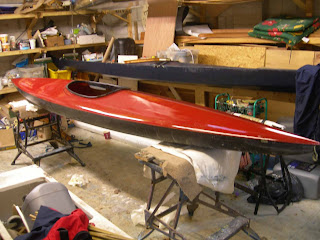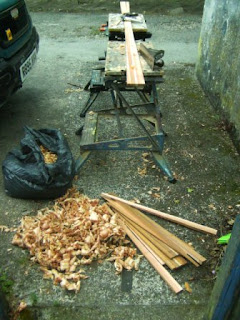Skin on Frame kayaks and Rot
Rot in the bow area of the boat
Although, skin removed, most of the frame was good one area was not:
The tip of the bow was covered in a white mould, parts were soft. Lifting the bow cap and forcing it away from the frame with a knife resulted in the section to come away in two parts. The whole area
was very soft with a strong "mushroomy" smell.
The cedar cap and bow plate was OK, but the reddish coloured
douglas fir (or whatever it was) with which I capped the gunwale had completely rotted.
Rot in skin on frame boats - Discussion
This is the fourth time I have stripped a skin on frame boat and the first time I have come across rot. All of frames had been treated with Burgess Hydrosol, a water based polymer treatment which seals the wood a little whilst allowing it to breathe. Salt water is also know to be quite a good preservative, so unlike fresh water left in the boat should not have posed a problem.
This boat had been neglected, left on a rack along the side of a building in a wet part of the country. Rain from the roof would have regularly poured over the inverted boat as there was no gutter in place over the rack, and water would have probably penetrated the skin at the bow loops. Although sealed with Sikaflex, sooner or later it would have found it's way through. This was a kayak that never really sealed well, and is one reason I never used enamel paint on polyester again. The stern area although damp was not soft or rotten despite having the same woods as the bow, probably because that part of the boat was away from the roof and open to the sunshine.
The Alacrity had an extreme bow shape:
As shown above, the air would have had great difficulty circulating in that region.. This boat also had bulkheads, which even with the hatch covers removed would have further restricted circulation. All of these factors lead me to believe that rot in this instance was due to neglect and design problems: the narrow raised bow and stern areas.
Prevention of Rot in skin on frame kayaks
Although, skin removed, most of the frame was good one area was not:
The tip of the bow was covered in a white mould, parts were soft. Lifting the bow cap and forcing it away from the frame with a knife resulted in the section to come away in two parts. The whole area
was very soft with a strong "mushroomy" smell.
The cedar cap and bow plate was OK, but the reddish coloured
douglas fir (or whatever it was) with which I capped the gunwale had completely rotted.
Rot in skin on frame boats - Discussion
This is the fourth time I have stripped a skin on frame boat and the first time I have come across rot. All of frames had been treated with Burgess Hydrosol, a water based polymer treatment which seals the wood a little whilst allowing it to breathe. Salt water is also know to be quite a good preservative, so unlike fresh water left in the boat should not have posed a problem.
This boat had been neglected, left on a rack along the side of a building in a wet part of the country. Rain from the roof would have regularly poured over the inverted boat as there was no gutter in place over the rack, and water would have probably penetrated the skin at the bow loops. Although sealed with Sikaflex, sooner or later it would have found it's way through. This was a kayak that never really sealed well, and is one reason I never used enamel paint on polyester again. The stern area although damp was not soft or rotten despite having the same woods as the bow, probably because that part of the boat was away from the roof and open to the sunshine.
The Alacrity had an extreme bow shape:
As shown above, the air would have had great difficulty circulating in that region.. This boat also had bulkheads, which even with the hatch covers removed would have further restricted circulation. All of these factors lead me to believe that rot in this instance was due to neglect and design problems: the narrow raised bow and stern areas.
Prevention of Rot in skin on frame kayaks
- Store the boat indoors if you live in a damp region
- Sponge the boat out and unless really necessary, try to avoid washing out with fresh water
- Let it dry out before inverting
- Use your boat often!
- If possible, avoid narrow pointy bows and sterns which can act like a sump when inverted
- Avoid deck lines which pierce the skin; sooner or later they will leak
- Lines can be attached to webbing, secured by plates screwed or bolted through the skin to the frame and which do not leak.







Comments
Post a Comment